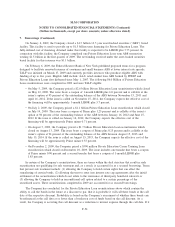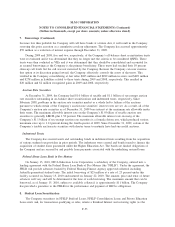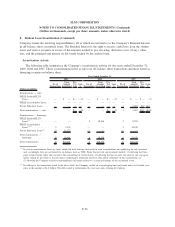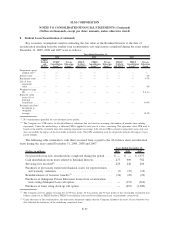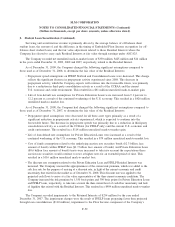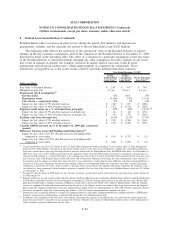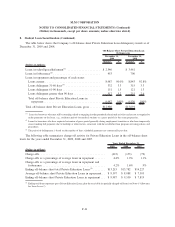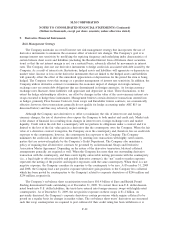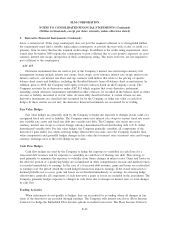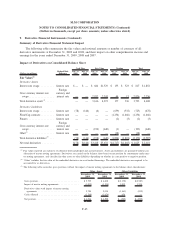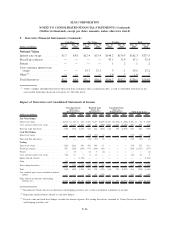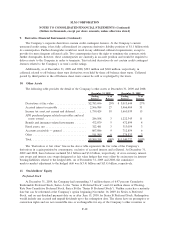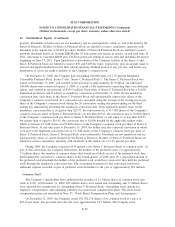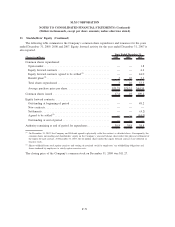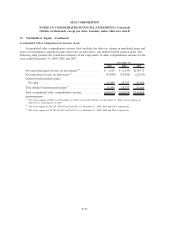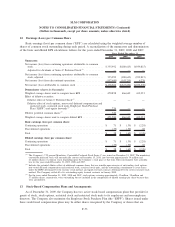Sallie Mae 2009 Annual Report Download - page 191
Download and view the complete annual report
Please find page 191 of the 2009 Sallie Mae annual report below. You can navigate through the pages in the report by either clicking on the pages listed below, or by using the keyword search tool below to find specific information within the annual report.9. Derivative Financial Instruments (Continued)
are written options which under ASC 815 have a more stringent effectiveness hurdle to meet. Therefore, these
relationships do not satisfy hedging qualifications under ASC 815, but are considered economic hedges for
risk management purposes. The Company uses this strategy to minimize its exposure to changes in interest
rates.
The Company uses basis swaps to minimize earnings variability caused by having different reset
characteristics on the Company’s interest-earning assets and interest-bearing liabilities. These swaps possess a
term of up to 14 years with a pay rate indexed to 91-day Treasury bill, 3-month commercial paper, 52-week
Treasury bill, LIBOR, Prime, or 1-year constant maturity Treasury rates. The specific terms and notional
amounts of the swaps are determined based on management’s review of its asset/liability structure, its
assessment of future interest rate relationships, and on other factors such as short-term strategic initiatives.
ASC 815 requires that when using basis swaps, the change in the cash flows of the hedge effectively offset
both the change in the cash flows of the asset and the change in the cash flows of the liability. The Company’s
basis swaps hedge variable interest rate risk; however, they generally do not meet this effectiveness test
because the index of the swap does not exactly match the index of the hedged assets as required by ASC 815.
Additionally, some of the Company’s FFELP loans can earn at either a variable or a fixed interest rate
depending on market interest rates. The Company also has basis swaps that do not meet the ASC 815
effectiveness test that economically hedge off-balance sheet instruments. As a result, under GAAP these swaps
are recorded at fair value with changes in fair value reflected currently in the statement of income.
Prior to 2008, the Company entered into equity forward contracts (see Note 11, “Stockholders’ Equity,”
for a further discussion of equity forward contracts and the settlement of all equity forward contracts in
January 2008). The Company utilized the strategy to lock in the purchase price of the Company’s stock to
better manage the cost of its share repurchases program. In order to qualify as a hedge under ASC 815, the
hedged item must impact net income. In this case, the repurchase of the Company’s shares did not impact net
income; therefore, the equity forwards did not qualify as a ASC 815 hedge. Prior to December 31, 2007, the
Company’s equity forward contracts provided for physical, net share or net cash settlement options. On
December 31, 2007, the terms of the contracts were changed to allow for physical settlement only. This
effectively changed the characteristics of the contracts so they no longer were derivatives accounted for under
ASC 815 and ASC 480 and instead were accounted for as a liability (recorded at the present value of the
repurchase price) under ASC 480. The Company has not had any outstanding contracts since January 2008.
F-64
SLM CORPORATION
NOTES TO CONSOLIDATED FINANCIAL STATEMENTS (Continued)
(Dollars in thousands, except per share amounts, unless otherwise stated)


